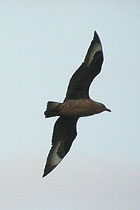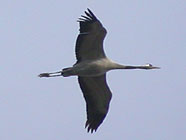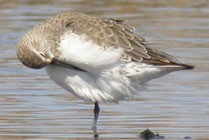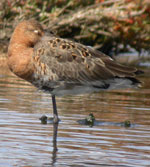 |
Spain: birds and birdwatching - part 2
by John Muddeman
Seabirds and allies in Spain
Given the immense length of the Spanish coasts, including the Canary Islands, it is no surprise that the variety of breeding and
 Great Skua
Great Skua
Catharacta skua
© John Muddeman
migrant seabirds is particularly high in a European context. In addition to the apparently endemic Balearic Shearwater,
large numbers of Cory's (two subspecies) and many fewer Manx, Yelkouan and Little Shearwaters, plus
Bulwer's Petrel and White-faced, European and Madeiran Storm-petrels also breed. Great and
Sooty Shearwaters and Wilson's and Leach's Storm-petrels are also regular on passage, albeit mainly offshore.
Additionally, one of the best seawatching points in Europe is in NW Spain. Birds cutting across the Bay of Biscay while heading
south catch the north-facing capes at e.g. Cabo de Estaca de Bares and large numbers of Northern Gannets, shearwaters, ducks,
waders, all four European breeding skuas, gulls, terns and auks pass mainly in autumn.
Regarding other 'sea' birds, Spain is outstanding as the global breeding stronghold of Audouin's Gull, and small colonies
of Slender-billed Gull are also present in select southern coastal wetlands. European Shags of both the European
Atlantic and Mediterranean races are resident in their respective areas. Terns include strong populations of breeding
Gull-billed (inland) and wintering Caspian, while Lesser Crested Tern is only regularly seen on migration in
Europe in the Strait of Gibraltar. Wintering birds include most of Britain's Atlantic Puffins in the western Mediterranean
and large numbers of Razorbill and Common Guillemot also pass and winter off the coasts where Common Scoter
 Common Crane
Common Crane
Grus grus
© John Muddeman
are locally abundant. Red-throated, Black-throated and Great Northern Divers all reach their southernmost
regular limits along the N Iberian coasts, along with a few Horned Grebe (which is a rarity in the rest of the country).
Wetland birds in Spain
Other winter visitors, mainly at coastal or inland wetlands include the majority of ducks to be found in Europe, excluding a number
of far N species. Red-crested Pochard and Marbled and White-headed Ducks maintain important breeding populations,
though the second is in a precarious state and the last is still recovering after a critical minimum of just 22 birds in the
1980s and is threatened by hybridisation with the introduced Ruddy Duck. Ferruginous Duck stills breeds at a couple
of spots, though is still extremely scarce, even in winter. Large numbers of Greylag Goose also occur in winter in select
wetland areas (e.g. Villafáfila, Doñana), with small numbers of much scarcer species accompanying them (e.g. Bean and
 Curlew Sandpiper
Curlew Sandpiper
Calidris ferrugineus
© John Muddeman
Greater White-fronted Geese), with a smattering of rare species turning up annually (e.g. Pink-footed Goose).
The wetlands -especially in the S half- of Spain are also important for other large birds, from the striking
Greater Flamingo and gregarious and increasing, but still very local Glossy Ibis, through a range of species including
Black Stork (C & SW), Eurasian Spoonbill, Great and Little Bitterns, Black-crowned Night,
Squacco and Purple Herons, Little and (in winter) increasing numbers of Great Egrets. Common Crane
winters in large numbers in certain areas, often roosting at the large lakes, while Spain is also important as the only European
country supporting a remnant and partly reintroduced population of Red-knobbed Coot (in Andalucía). Though always difficult
to see, Spotted, Little, Baillon's and Corn Crakes all occur, though largely on passage, while
 Black-tailed Godwit
Black-tailed Godwit
Limosa limosa
© John Muddeman
Water Rail is much more widespread. Smaller birds of these habitats include Yellow Wagtail (of the iberiae race)
and a series of warblers, including Zitting Cisticola, Cetti's, Savi's, Moustached (very local),
and Great Reed Warblers, Bearded Reedling (E half of Spain only), Eurasian Penduline Tit and Common Reed
Bunting (subspecies witherbyi and lusitanica).
Waders of a wide variety can be found both at selected inland and coastal sites, including important breeding populations of
smart Black-winged Stilt and Pied Avocet, charming Collared Pratincole and Little Ringed and Kentish
Plovers. The number of migrant and wintering species is much higher however, with remarkable diversity even at some
inland sites on passage (e.g. Azud del Río Lobos and the lakes of La Mancha). Given the warm areas in the S, species often thought
of as wintering in Africa stay in small numbers throughout the winter, e.g. a few Eurasian Dotterel inland near the S coast
and Little Ringed Plover, Temminck's Stint, Curlew, Marsh and Wood Sandpipers & Spotted
Redshank. The country also acts as a winter haven when C and N Europe freeze over and Grey Plover, huge numbers of
European Golden Plover, Northern Lapwing and Common Snipe, Sanderling, Little Stint,
Dunlin, Eurasian Woodcock (also breeds), Black-tailed and Bar-tailed Godwits, Eurasian Curlew,
Green and Common (also breeds) Sandpipers and Ruddy Turnstone all regularly winter. Scarcer species
include Jack Snipe, Purple Sandpiper (N coasts), Ruff at various sites, Whimbrel (mainly Atlantic coasts)
and Common Greenshank (± throughout).
|